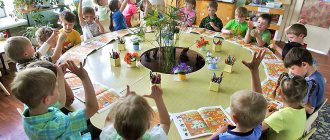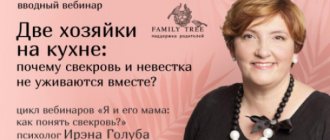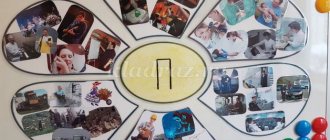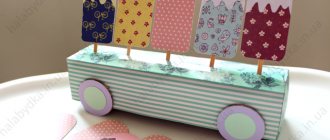The purpose of the didactic game “What’s extra”
The goal is to develop the skill of classifying objects according to key features, visual analysis and generalization.
Tasks:
- improving the ability to classify;
- expanding your horizons and ideas about the world around you;
- fostering cognitive interest;
- enrichment of individual vocabulary;
- improving visual perception;
- development of memory, intelligence, ability to think figuratively and logically.
On the topic: methodological developments, presentations and notes
A didactic game is a multifaceted, complex pedagogical phenomenon: it is both a playful method of teaching preschool children, a form of learning, and independent play.
By environmental education of children we must understand, first of all, the education of humanity, that is, kindness, a responsible attitude towards nature, and towards the people who live nearby, and towards the descendants of whom.
Developed by: Salamatina Irina Borisovna teacher of GBDOU No. 48 of the Kirov region with peas or beans). St. Petersburg Description of the game: Goal: development of fine motor skills, tactile sensitivity.
Educational didactic games.
We develop fine motor skills, learn to connect parts of an object into one whole, name an object, determine its color. We develop memory, thinking, attention, increase vocabulary. Fasten p.
This game will help a 6-7 year old child become familiar with heraldry. The game contains two games that will interest any preschooler. The didactic game “Flags of the World” will allow the child to learn not only flags.
Sound culture of speech in a fascinating incident with lost pets.
Source
Didactic game “Extra object”
To play, you need cards depicting 4 objects, one of which differs from the others in one or more key ways. The teacher invites the students to look at the images, name each object and its purpose, then point to the 4th extra object. It is important that the preschooler explains in detail why he chose this particular object. For example, the card shows an apple, a peach, a tomato, and an orange. The child chooses a tomato, explains that it is a vegetable, and the rest of the images are fruits.
Do not rush the student, give him time to think and give a competent and detailed answer. The subject of the images can be anything, as long as it corresponds to the child’s age knowledge. For children 3–4 years old, the preferred themes are “Toys”, “Animal World”, “Flora World”, “Seasons”, “Household Items”. For preschoolers 5–6 years old, you can prepare cards “Musical Instruments”, “Garden and Vegetable Garden”, “Mathematics and Geometry”, “Transport”, “Furniture”.
The game can be organized in the form of solving riddles. The teacher lays out 4 images in front of the student, then asks a riddle about the extra object. The child, having guessed the riddle, finds out which of the presented objects is the odd one out, then reasons why this is so.
Interactive children's presentation “Journey into Space”
Author:
Yagovkina Marina Vladimirovna,
teacher,
highest qualification category
MADO kindergarten No. 126 in Tyumen
Journey into space
(integrated educational activities)
Program content:
- Practice the ability to restore the order of numbers in ascending order.
- Recognize familiar geometric shapes, make a figure from a geometric constructor according to a diagram.
- Test your ability to form a whole from parts and name each part.
- Fix the countdown, the composition of the numbers within 4.
- Continue to develop the ability to divide words into syllables, choose words with the same root, name the first letter in a word
- Expand your understanding of constellations and planets of the solar system.
- Develop logical thinking, imagination, and reasoning skills.
Materials:
- Ø Multimedia installation
- Ø Rocket diagram, geometric constructors (for each child);
- Ø Stars: 3 large with number houses, 12 small with numbers;
- Ø Tape recorder, star music, distress signal;
- Ø Planet Jupiter divided into 4 parts and two other cosmic bodies;
- Ø Star, star stickers
Educator: Hello, guys! Today we have guests, let's say hello to them. (Slide 2)
Today we will go on a journey with you. What can you go on a trip with? (Slide No. 3)
Children's answers: by train, by car, by bus...
Educator: I suggest you guess what we are going on.
Game “Add the letters in ascending order of numbers” (Slide No. 4)
I have the name of this transport here. (the teacher opens the box, and there are letters and numbers on magnets), for this we need to arrange all the numbers in ascending numerical order and we will find out what we will take on the journey.
The child puts the numbers in order and reads the word: ROCKET.
| 1 | 2 | 3 | 4 | 5 | 6 |
| R | A | TO | E | T | A |
Educator: Where can we go on a rocket?
Children's answers: to space, to the moon...
Educator: Today we will go on a journey on a rocket into space, we will make stops on various planets. Where is our rocket? Here it is (Slide No. 5).
What geometric shapes does our rocket consist of?
Children's answers: from a triangle, a rectangle, a circle
Educator: Let's go to the table and build the same rockets.
Children use their geometric construction set to build rockets.
Educator: Well done! Now it's time to hit the road. We begin launching the rocket: 10, 9, 8, 7, 6, 5, 4, 3, 2, 1. (Slide No. 6)
— Guys, the rocket won’t start. We forgot the key to start the rocket.
Graphic dictation:
8 cells right, 2 cells up, 4 cells right, 5 cells down, 4 cells left, 2 cells up, 4 cells left, 2 cells up, 4 cells left, 3 cells down, 1 cell left, 1 cell up, 1 cell left, 1 cell down, 1 cell left, 3 cells up, 1 cell left, 1 cell up.
- Whoever completed the task correctly received the key to start the rocket. (Slide No. 7)
And now that we have the key, let’s start the rocket again: 10, 9,8,7,6, 5, 4, 3, 2, 1, launch (Slide No. 8)
Cosmic music sounds (Slide No. 9)
- So we fly, we enter weightlessness.
Children move in different directions and fly.
Educator: Look out the windows, we are flying through different constellations:
- This is Ursa Major. Count how many stars are there in this constellation? (Slide No. 10)
Children: Seven.
Educator: This constellation is called Orion, count how many stars are in this constellation? (Slide No. 11)
Children: Eight.
Educator: This constellation is called Cassiopeia, count how many stars are in it? (Slide No. 12)
Children: Five.
All these constellations are available for observation in our country at any time of the year.
Educator: Our ship flew up to a cluster of stars. So many stars! What are these stars in size? (Slide No. 13)
Children: Big and small.
Educator: Let's collect the stars. Boys collect big stars, and girls collect small ones.
Children collect stars.
Educator: Well done, guys! Oh, these are not ordinary stars.
Big stars are houses for little stars. We need to distribute the stars among the houses.
Game "Number Houses"
Educator: Guys, are we flying further?
A distress signal is heard (Slide No. 14)
Educator: Guys, the planet Jupiter is asking for help. A meteorite hit the planet and it split into pieces. The parts scattered in space and mixed with other parts of cosmic bodies, comets and asteroids. Task: assemble a planet from 4 equally sized parts.
Children come to the table and together collect planets and find the desired planet.
Educator: Which of these planets is Jupiter?
Children's answers. (Slide No. 15)
Educator: How did you guess?
Children: Planet Jupiter broke into four parts.
Educator: What is the name of each part of the planet?
Children: one fourth (Slide No. 16)
Educator: Attention! We are descending to the nearest planet. We leave the ship. It wouldn't hurt to warm up a little.
Physical exercise “Let's be cosmonauts” (Slide No. 17)
One, two - there is a rocket. Children raise their hands up, Three, four - take off soon. spread their arms to the sides, To fly to the Sun they make a circle with their arms, Cosmonauts need a year But on the road we are not afraid, arms to the sides, bending the body, Each of us is an athlete. squatting, bending and unbending their arms. Flying over the Earth at the elbows, raising their arms up. Let's say hello to her. and wave
Educator: To go further on our journey, we need to make our way through the asteroid belt. (Slide No. 18)
We will be saved if we find the way correctly. We need to find extra words.
Game "Fourth wheel"
- 1. Space, astronaut, spacesuit, space (Slide No. 19)
- 2. Asterisk, stellar, star, asteroid (Slide No. 20)
- 3. Earth, earthlings, earthly, planetary. (Slide No. 21)
- 4. Lunatic, Moon, Lunar, crater (Slide No. 22)
Educator: Why is this word superfluous?
Children's answers
Educator: Guys, it’s time for us to return to Earth (Slide No. 23)
We returned from the flight
And they landed on Earth.
Our journey is over.
- Look, a star fell from the sky! (Slide No. 24)
They say that when a star falls, you can make a wish and it will definitely come true. Do you want to make a wish?
Children pass the star and make wishes.
Educator: I also want to make a wish: that you will always be as friendly, brave, smart, quick-witted as during our journey. And the star brought you little gifts: little stars - stickers. (Slide No. 25)
From the portal administration: Presented demo version for review. The full version will be in the multimedia album of the virtual exhibition, which each participant will receive.
Dear teachers and parents - participants of the exhibition!
On June 2, 2015, a solemn ceremony of awarding the winners of the regional methodological exhibition “Modern educational environment of kindergarten and family” took place at the information and exhibition complex of the Tyumen Regional Duma. Details >>>
From June 8 to June 10, 2015, teachers from Tyumen received certificates of exhibition participants and multimedia albums with the full version of the exhibition at the Grant Center for the Development of Creativity for Children and Youth at the address: Profsoyuznaya St., 52. tel. for inquiries: 685-321,
June 9, 2015 Diplomas, certificates and gifts were sent to the winners and participants of the Exhibition of the south of the Tyumen region, Yamal-Nenets Autonomous Okrug and Khanty-Mansi Autonomous Okrug-Yugra by registered parcel post to the address of the preschool educational institution. Details >>>
Share








